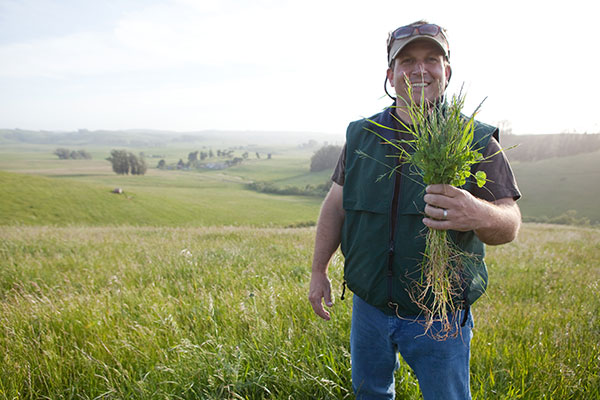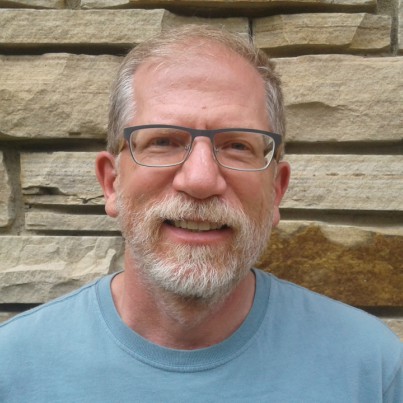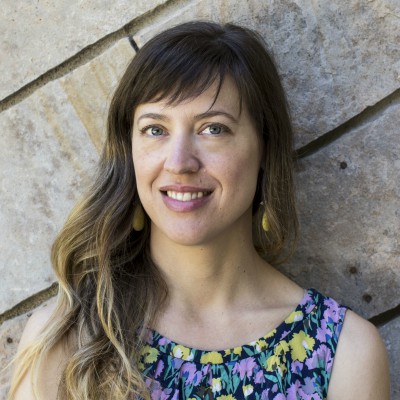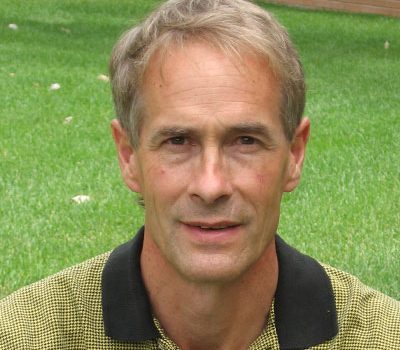
The Blue Plate: A Food Lover’s Guide to Climate Change
Written by Isabella A. Oleksy, a Ph.D. candidate in the Graduate Degree Program in Ecology.
Recently, Mark Easter, a Senior Research Associate in the Natural Resource Ecology Laboratory, was initiated into the CSU School of Global Environmental Sustainability’s (SoGES) Resident Fellows program. This fellowship will help fund a book project that will be written in collaboration with Amy Swan and Keith Paustian. The Blue Plate: A Food Lover’s Guide to Climate Change, will synthesize decades of field research and computer models in an analysis of food production and the associated carbon footprints of our favorite food staples—from salmon to sugar cane to wheat. This award from SoGES will help fund additional visits to food producers and harvesters between Florida to Alaska, in an effort to further highlight the success stories of greenhouse gas emission conscious producers in our global food system and exemplary carbon farmers in American ranching.

The Blue Plate is written for a general audience and will intrigue even the most carbon-conscious eater. While there are many familiar and well-known examples of books in the popular science sphere relating to sustainable food production (e.g., Omnivore’s Dilemma by Michael Pollen) and fish harvesting (e.g., Four Fish by Paul Greenberg), The Blue Plate may just be the most integrative view of the American food system—from farmer to family dinner. Have you ever wondered which is more sustainable—fresh or frozen fish? Local conventional or distant organic lettuce? The authors will illuminate simple changes in behavior that consumers can make to reduce their own carbon footprint at the grocery store, with engaging stories that retrace the food supply chain. After reading about the lives of innovative farmers and ranchers who are implementing new techniques to reduce greenhouse gas emissions, readers will be left feeling optimistic and hopeful about the future of food in the United States.
Work on The Blue Plate is progressing rapidly, and the authors anticipate submitting to a publisher within a year. We look forward to the final product!
 Mark Easter is a Senior Research Associate at the Natural Resource Ecology Laboratory. Mark has been working on greenhouse gas inventories and decision support systems since 1999, and it remains a principal focus in his work. He earned an M.S. in Botany with an emphasis in Physiological Ecology at the University of Vermont in 1991. His work focuses on greenhouse gas inventories and greenhouse gas decision support systems in agriculture and forestry. He tries to answer questions like: What are the total greenhouse gases that come from growing a bushel of corn? How can we raise carbon-neutral wheat? If we composted all of our food scraps, paper, and yard waste, and used the compost to help grow food, could we reduce global warming?
Mark Easter is a Senior Research Associate at the Natural Resource Ecology Laboratory. Mark has been working on greenhouse gas inventories and decision support systems since 1999, and it remains a principal focus in his work. He earned an M.S. in Botany with an emphasis in Physiological Ecology at the University of Vermont in 1991. His work focuses on greenhouse gas inventories and greenhouse gas decision support systems in agriculture and forestry. He tries to answer questions like: What are the total greenhouse gases that come from growing a bushel of corn? How can we raise carbon-neutral wheat? If we composted all of our food scraps, paper, and yard waste, and used the compost to help grow food, could we reduce global warming?
 Amy Swan is a Project Scientist at the Natural Resource Ecology Laboratory at Colorado State University. She has worked on a variety of research projects that evaluate the impacts of agricultural management and land use change on greenhouse gas cycling in ecosystems. She contributed to the U.S. EPA National Greenhouse Gas Inventory for the several years, as well as supported development of web-based tools to estimate greenhouse gas emissions from farms and ranches in the U.S. (COMET-Planner and COMET-Farm) and sustainable land management projects in the developing world. Amy’s experience in soil carbon research ranges from extensive on-farm/ranch soil sampling and analysis to simulating agricultural ecosystems in the Century and DayCent ecosystem models. She received a BSc in Environmental Management from South Dakota State University and MSc in Ecology at Colorado State University.
Amy Swan is a Project Scientist at the Natural Resource Ecology Laboratory at Colorado State University. She has worked on a variety of research projects that evaluate the impacts of agricultural management and land use change on greenhouse gas cycling in ecosystems. She contributed to the U.S. EPA National Greenhouse Gas Inventory for the several years, as well as supported development of web-based tools to estimate greenhouse gas emissions from farms and ranches in the U.S. (COMET-Planner and COMET-Farm) and sustainable land management projects in the developing world. Amy’s experience in soil carbon research ranges from extensive on-farm/ranch soil sampling and analysis to simulating agricultural ecosystems in the Century and DayCent ecosystem models. She received a BSc in Environmental Management from South Dakota State University and MSc in Ecology at Colorado State University.
 Keith Paustian is University Distinguished Professor in the Department of Soil and Crop Sciences and Senior Research Scientist at the Natural Resource Ecology Laboratory at Colorado State University. A major focus of his work involves modeling, field measurement and development of assessment tools for soil carbon sequestration and greenhouse gas emissions from soils. Dr. Paustian was the convening lead authors on the Guidelines for National GHG Inventories and the special section on land use, land use change, and forestry sections of the 2006 Intergovernmental Panel on Climate Change (IPCC) report. Additionally, Dr. Paustian was part of a distinguished group of NREL scientists to receive the Nobel Peace Prize in 2007 for their work on understanding climate change.
Keith Paustian is University Distinguished Professor in the Department of Soil and Crop Sciences and Senior Research Scientist at the Natural Resource Ecology Laboratory at Colorado State University. A major focus of his work involves modeling, field measurement and development of assessment tools for soil carbon sequestration and greenhouse gas emissions from soils. Dr. Paustian was the convening lead authors on the Guidelines for National GHG Inventories and the special section on land use, land use change, and forestry sections of the 2006 Intergovernmental Panel on Climate Change (IPCC) report. Additionally, Dr. Paustian was part of a distinguished group of NREL scientists to receive the Nobel Peace Prize in 2007 for their work on understanding climate change.